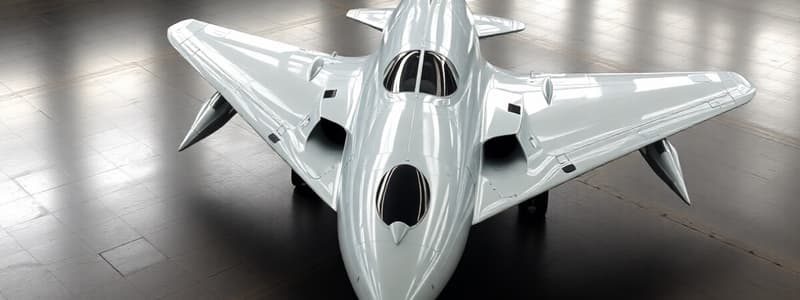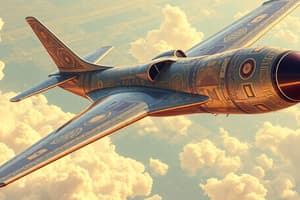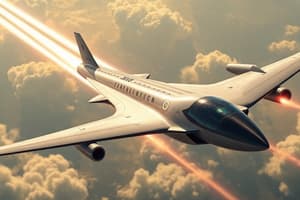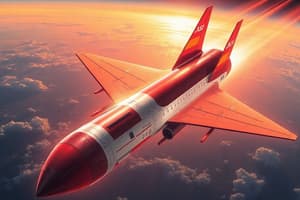Podcast
Questions and Answers
What is the primary aim of NASA's X-59 aircraft?
What is the primary aim of NASA's X-59 aircraft?
- To increase the speed of traditional passenger planes.
- To test new materials for aircraft construction.
- To reduce travel time over bodies of water.
- To allow supersonic flights over land without noise disturbance. (correct)
What unique feature of the X-59 helps reduce the sonic boom?
What unique feature of the X-59 helps reduce the sonic boom?
- The size of its wings.
- Its pointed nose design. (correct)
- Its lightweight structure.
- The position of its engines.
How does the X-59 pilot navigate the aircraft instead of using a forward-facing window?
How does the X-59 pilot navigate the aircraft instead of using a forward-facing window?
- With the help of radar technology.
- Using traditional instruments and dials.
- Through advanced camera systems placed at the front. (correct)
- By relying on air traffic control's instructions.
What was one of the main reasons for the failure of the Concorde?
What was one of the main reasons for the failure of the Concorde?
What future development does NASA hope the successful testing of the X-59 will lead to?
What future development does NASA hope the successful testing of the X-59 will lead to?
When does NASA plan to begin testing the X-59?
When does NASA plan to begin testing the X-59?
What innovative mission is NASA's X-59 a part of?
What innovative mission is NASA's X-59 a part of?
What does the design of the X-59's engines accomplish?
What does the design of the X-59's engines accomplish?
What is the purpose of the extended nose on the supersonic transport aircraft?
What is the purpose of the extended nose on the supersonic transport aircraft?
The aircraft's fixed canard serves primarily as a:
The aircraft's fixed canard serves primarily as a:
Which of these design features is NOT directly related to reducing the sonic boom impact?
Which of these design features is NOT directly related to reducing the sonic boom impact?
What is the main advantage of using a GE F4D4 engine with a standard production nozzle in this aircraft design?
What is the main advantage of using a GE F4D4 engine with a standard production nozzle in this aircraft design?
Which of the following design features is meant to improve the pilot's view during flight?
Which of the following design features is meant to improve the pilot's view during flight?
What is the primary objective of NASA's research regarding the X-59's sonic boom?
What is the primary objective of NASA's research regarding the X-59's sonic boom?
Which of the following is NOT directly related to the X-59's development in terms of its design or construction?
Which of the following is NOT directly related to the X-59's development in terms of its design or construction?
Given the challenges of achieving a quieter sonic boom, what is a potential concern regarding the X-59's commercial viability?
Given the challenges of achieving a quieter sonic boom, what is a potential concern regarding the X-59's commercial viability?
What is the implied connection between NASA's research on supersonic booms and the potential for commercial supersonic flight?
What is the implied connection between NASA's research on supersonic booms and the potential for commercial supersonic flight?
Based on the information provided, what is an indirect consequence of the X-59's development?
Based on the information provided, what is an indirect consequence of the X-59's development?
What is the primary driving force behind the X-59's engineering design?
What is the primary driving force behind the X-59's engineering design?
Considering the challenges of reaching a quieter sonic boom, what is the significance of NASA's research on extreme-dive maneuvers?
Considering the challenges of reaching a quieter sonic boom, what is the significance of NASA's research on extreme-dive maneuvers?
Which of the following is a potential risk or challenge associated with the X-59 project?
Which of the following is a potential risk or challenge associated with the X-59 project?
Flashcards
Supersonic Speed
Supersonic Speed
The speed of an object that is faster than the speed of sound, typically around 768 mph (1,236 km/h).
Sonic Boom
Sonic Boom
The loud noise created when an aircraft breaks the sound barrier, often described as a booming sound.
X-59 Aircraft
X-59 Aircraft
NASA's X-59 is a prototype aircraft designed to achieve supersonic flight without creating a loud sonic boom.
QueSST (Quiet SuperSonic Technology)
QueSST (Quiet SuperSonic Technology)
Signup and view all the flashcards
X-59's Quiet Design Features
X-59's Quiet Design Features
Signup and view all the flashcards
No Forward-Facing Cockpit Window
No Forward-Facing Cockpit Window
Signup and view all the flashcards
X-59 Testing and Feedback
X-59 Testing and Feedback
Signup and view all the flashcards
Future of Supersonic Flight
Future of Supersonic Flight
Signup and view all the flashcards
What is a sonic boom?
What is a sonic boom?
Signup and view all the flashcards
How does X-59 reduce sonic boom?
How does X-59 reduce sonic boom?
Signup and view all the flashcards
What is unique about X-59's cockpit?
What is unique about X-59's cockpit?
Signup and view all the flashcards
Why is quieter sonic boom important?
Why is quieter sonic boom important?
Signup and view all the flashcards
How is X-59's quietness being tested?
How is X-59's quietness being tested?
Signup and view all the flashcards
When will we see X-59 in action?
When will we see X-59 in action?
Signup and view all the flashcards
What are the challenges with supersonic flight?
What are the challenges with supersonic flight?
Signup and view all the flashcards
How does NASA study sonic booms?
How does NASA study sonic booms?
Signup and view all the flashcards
Extended Nose
Extended Nose
Signup and view all the flashcards
Fixed Canard
Fixed Canard
Signup and view all the flashcards
Single Piece Wing Skins
Single Piece Wing Skins
Signup and view all the flashcards
Mini T-tail
Mini T-tail
Signup and view all the flashcards
Conventional Tail with Mini T-tail
Conventional Tail with Mini T-tail
Signup and view all the flashcards
Study Notes
NASA's X-59 Supersonic Aircraft
- NASA's X-59 aims to make supersonic flight significantly faster, safer, more sustainable, and quieter than existing options, achieving supersonic speeds without producing a sonic boom.
- The aircraft is part of NASA's Quiet SuperSonic Technology (QueSST) program.
- The goal is to reduce the loud sonic boom to a level comparable to a car door closing.
- Supersonic speed is faster than the speed of sound, approximately 768 mph (1,236 km/h).
- Sonic booms are a loud, disruptive noise, potentially damaging structures, caused by shock waves created when an aircraft breaks the sound barrier.
- The Concorde's flight routes were limited primarily over water due to sonic boom restrictions.
- The X-59's unique design, including a long, slender fuselage, a specially shaped nose, and a “quiet” engine, reduces shock waves and noise.
- The cockpit lacks a forward-facing window, relying on an External Vision System (XVS) with a 4K HD camera feed.
- Testing is planned for late 2024 in California, moving to flights over US cities to gauge public feedback on the sound.
- This data could potentially change regulations to allow supersonic flights over land.
- Successful testing could lead to new commercial supersonic cargo and passenger aircraft by 2035.
- Lockheed Martin is building the X-59 in Palmdale, California.
- Building the aircraft involved innovative techniques, including VR modeling and a movable robot for faster and more precise assembly.
- Modifications incorporated technology from various sources, including an F-16 landing gear and a T-38 cockpit..
- Estimated project cost is $630 million, exceeding the initial budget.
- Critics question whether demand will justify this significant investment.
- Research involves extreme-dive maneuvers to study supersonic boom impact.
- Testing will include flights over locations like San Diego to collect data on performance and noise levels.
Sonic Booms, Regulations & Commercial Supersonic Flight
- Sonic booms are created by shock waves produced by an aircraft traveling faster than the speed of sound.
- Sonic booms are disruptive and are not permitted over land in the United States.
- NASA's program aims to develop quieter supersonic flight technology, potentially changing regulations for supersonic flight over land.
- Successful development could significantly reduce travel times, for example, reducing coast-to-coast travel from five hours to two and a half hours.
Studying That Suits You
Use AI to generate personalized quizzes and flashcards to suit your learning preferences.





